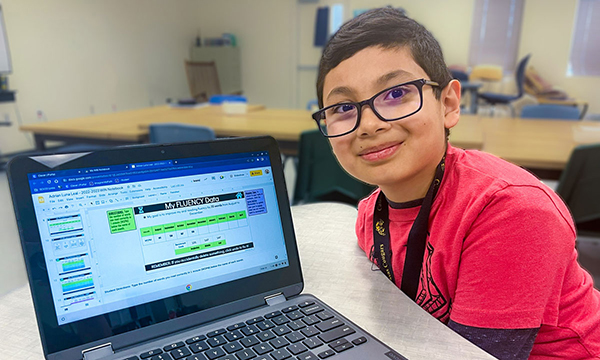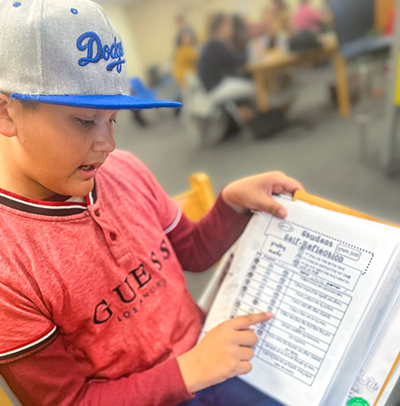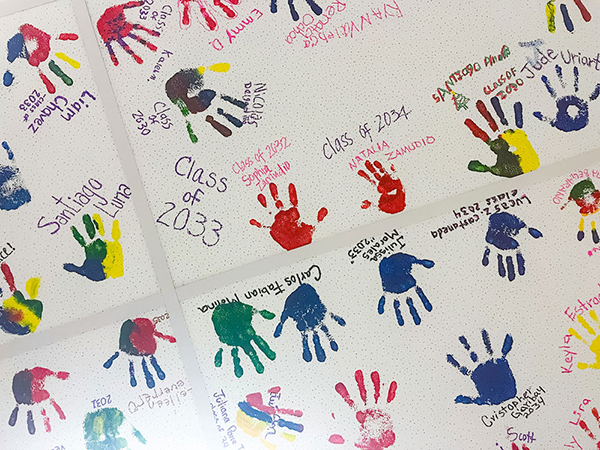How Standards-Based Grading Is Empowering Arizona Students to Own Their Education
Kuhlmann & Taylor: Inside a 3-year experiment to rethink grading and student achievement through the lens of personalized & competency-based learning.

The move towards personalized, competency-based learning in Arizona’s Santa Cruz Valley Unified School District (SCVUSD) began with a very basic question — “Are we doing what is best for our kids?”
For more than three years now, SCVUSD has been working to shift the way it thinks about student achievement and grades as they work to integrate personalized, competency-based learning into district-wide strategies. This includes a move towards competency-based evaluation and standards-based grading.
Students at Calabasas School, one of five SCVUSD schools, track their own growth in WIN notebooks – a physical binder for kindergarten through fourth graders and a digital document for fifth through eighth graders. WIN stands for “What I Need.”
Learners set goals for their academic growth in partnership with their teachers — easily pointing to where they started with their reading and math fluency, and where they’re going. The focus isn’t on what they don’t know, but instead on what they don’t know yet
The goal is to work towards proficiency. Students progress between levels of understanding, not grades. Level one being the typical starting point for most learners, three being proficient and four indicating mastery. The expectation is that most learners will progress to a three or a four in each standard by year’s end. If not, they can try again until they demonstrate proficiency in that area. What students have learned and still need to learn is prioritized over a single grade at a single point in time.
In a traditional grading system, arbitrary measures such as extra credit, classroom behavior or classroom participation are used to calculate a percentage — an 80 percent in one subject might mean something completely different than it does in another and provides little evidence of what has been learned. By contrast, standards-based grading moves students through a learning continuum and only when the student has demonstrated mastery are they moved to a subsequent level.

Through ongoing observational and formative assessment, teachers know where their students are and what they need. A teacher might create playlists or choice boards, for example, with five potential activities aligned to a standard. Students then choose three activities based on the options presented for the learners’ current level placement. Students cultivate agency by making meaningful choices about how they’ll practice and how they will demonstrate their learning. Individual activities are complemented with teacher-facilitated small group work.
The big question on the mind of many educators when considering a move to a competency-based learning approach is often, “How will this actually look and work in my classroom?”
Opportunities to share lessons learned through “inquiry labs” have helped Arizona educators connect theory with practice by seeing it in action. As part of the state-led support system for personalized learning, through a partnership with the Center for the Future of Arizona and KnowledgeWorks, inquiry labs invite fellow educators for site visits where they can observe teaching and learning strategies, ask questions and leverage best practices and lessons learned.
In addition, the Arizona Personalized Learning Network provides pathways for individual educators, schools and districts to adopt, scale and spread personalized, competency-based learning with the goal of shifting systems. The network is a professional learning community made up of educators that are actively pursuing student-centered learning strategies in the classroom. KnowledgeWorks convenes these professional learning communities, offering teachers the support and professional development they need to try new things, prototype new strategies and shift their role in the classroom.
Martina Alvarez, a former math teacher at Rio Rico High School in SCVUSD, once skeptical of standards-based grading, is now its greatest advocate. After recognizing that in the traditional grading model assigning a failing grade had finality – the learning had ended, but the gaps in knowledge remained. By contrast, with standards-based grading, when a student earns a 1 or 2, they work with their teachers to create a learning plan to figure out what needs to be done to reach proficiency. Learning becomes cyclical, rather than a linear path students progress along whether they understand the content or not. Solving algebraic equations becomes a nearly impossible feat if you don’t first know how to multiply and divide fractions.
For Yuki Carrillo, a third-grade teacher at Calabasas School, standards-based grading has also been well received by parents. While Carrillo is available to answer questions, student-led conferences allow students to explain their strengths, where they have gaps in learning, and most importantly, what comes next to advance along the continuum. It’s not a secret what they’ll be tested on, everyone has a shared understanding of what needs to be learned in order to advance to the next level.
Schools that change the way they think about grading must also change how they acknowledge academic achievement. Instead of the typical honor roll ceremonies, Calabasas School invites families to recognize their child’s academic growth, proficiencies and MAP scores.

In addition to a traditional certificate of achievement, elementary students embellish school ceiling tiles with painted handprints including their names and the year they will graduate. Middle grade students select a rock from the campus’ landscape and paint it before returning it to one of the campus’ many pathways. Their efforts feel tangible.
There’s a powerful feeling of hopefulness when you see children learning who they are and what they need to succeed. It makes you wonder why it can’t be like this in every school, for every student.

Jillian Kuhlmann is the senior manager of communications at KnowledgeWorks where she works to share stories of innovation in teaching and learning and helps raise awareness about the work happening in the field of personalized, competency-based learning across the country. She is a published fiction author and avid believer in the power of stories to shape human understanding.
Shelby Taylor is the director of communications at KnowledgeWorks and works closely with state implementation teams to scale and spread personalized competency-based learning by growing the knowledge base and sharing stories of success in state policy and in schools.

